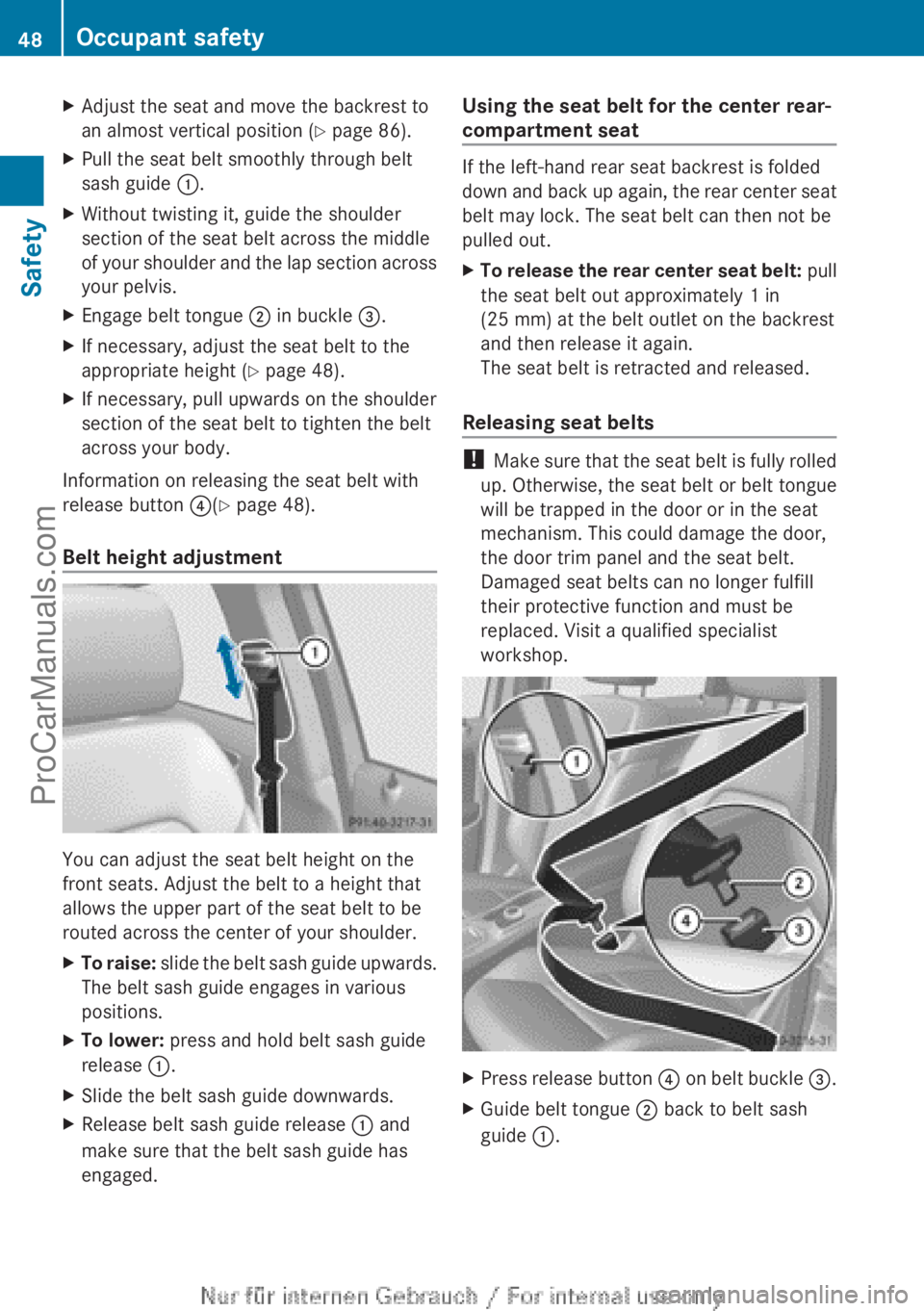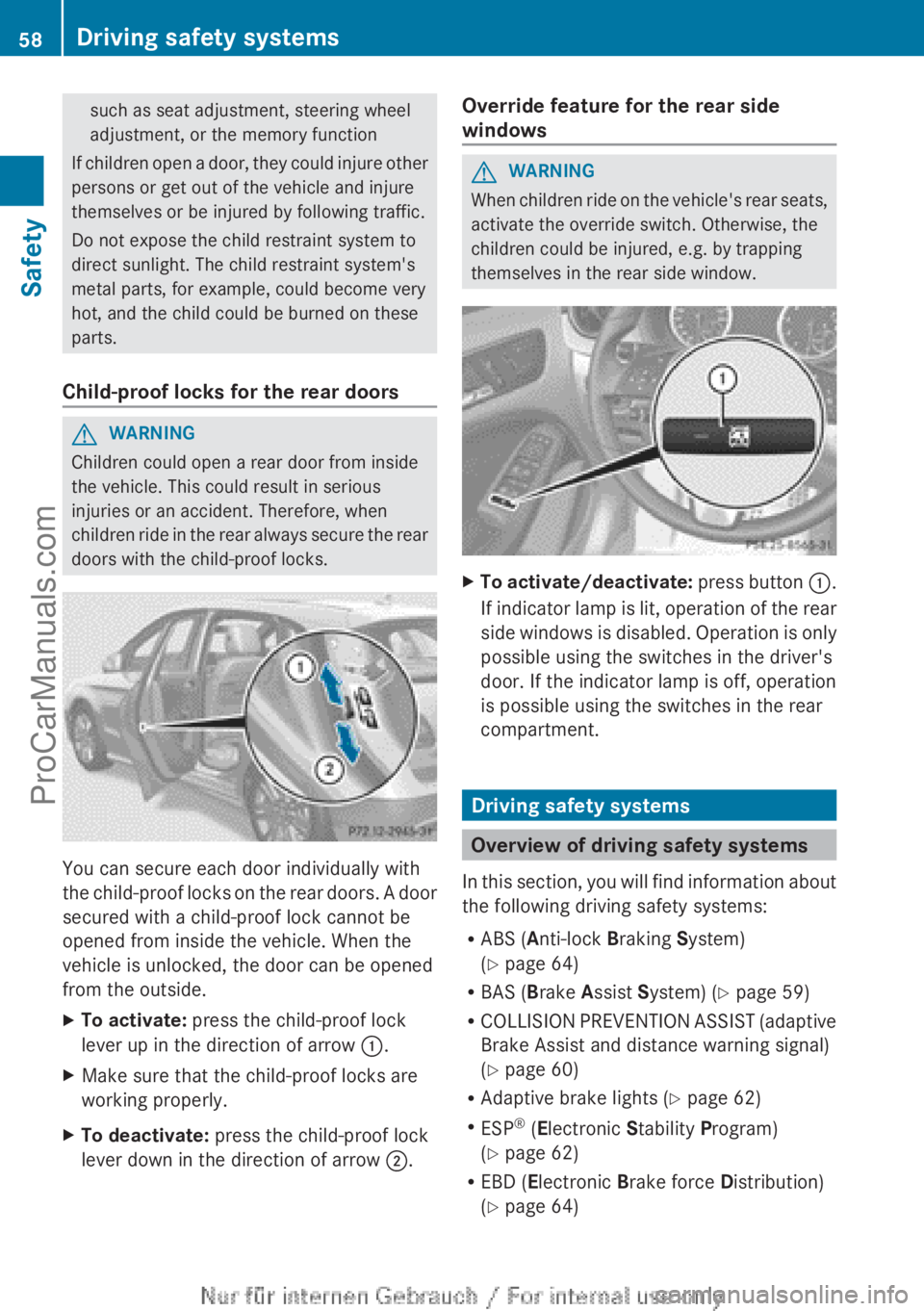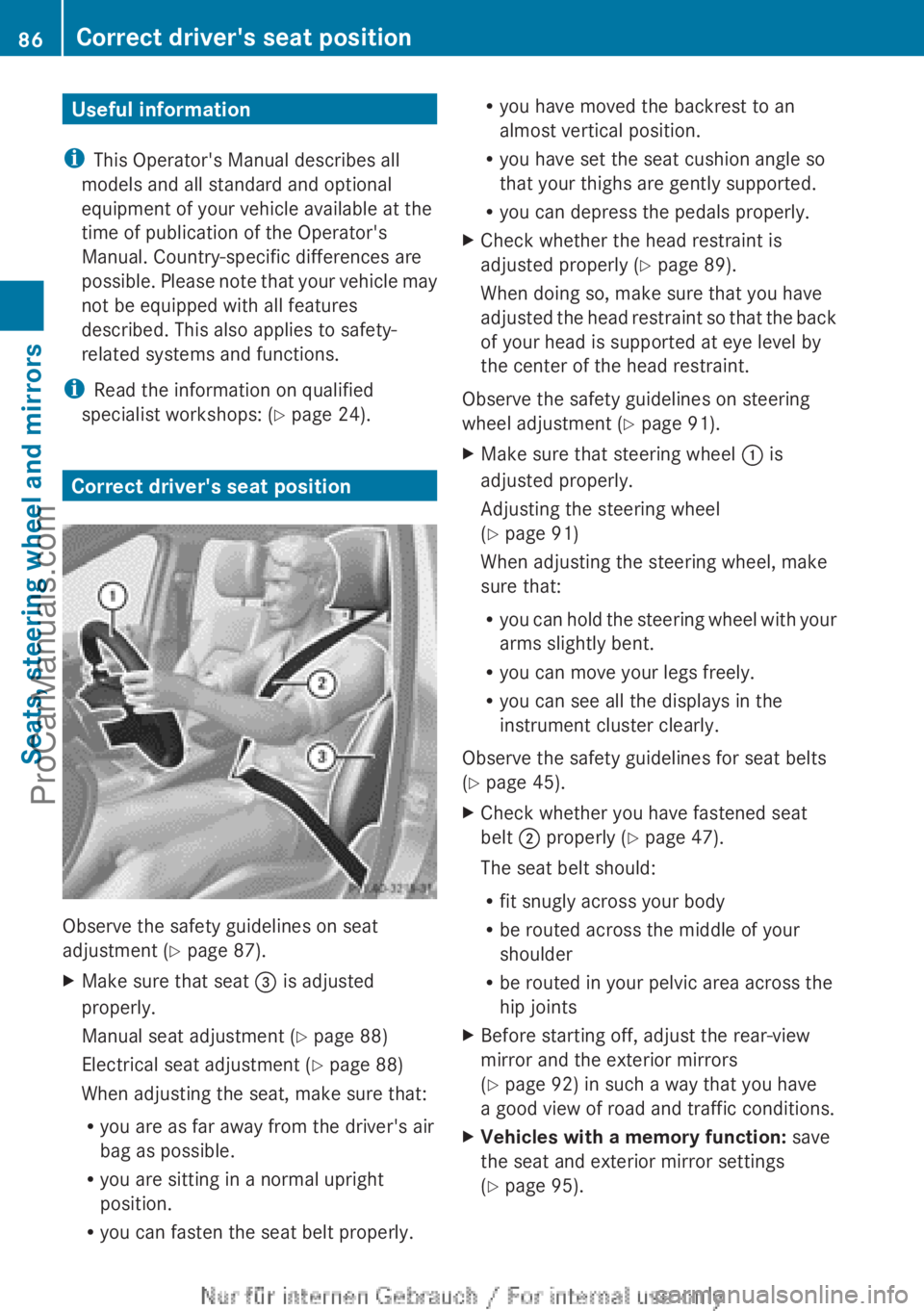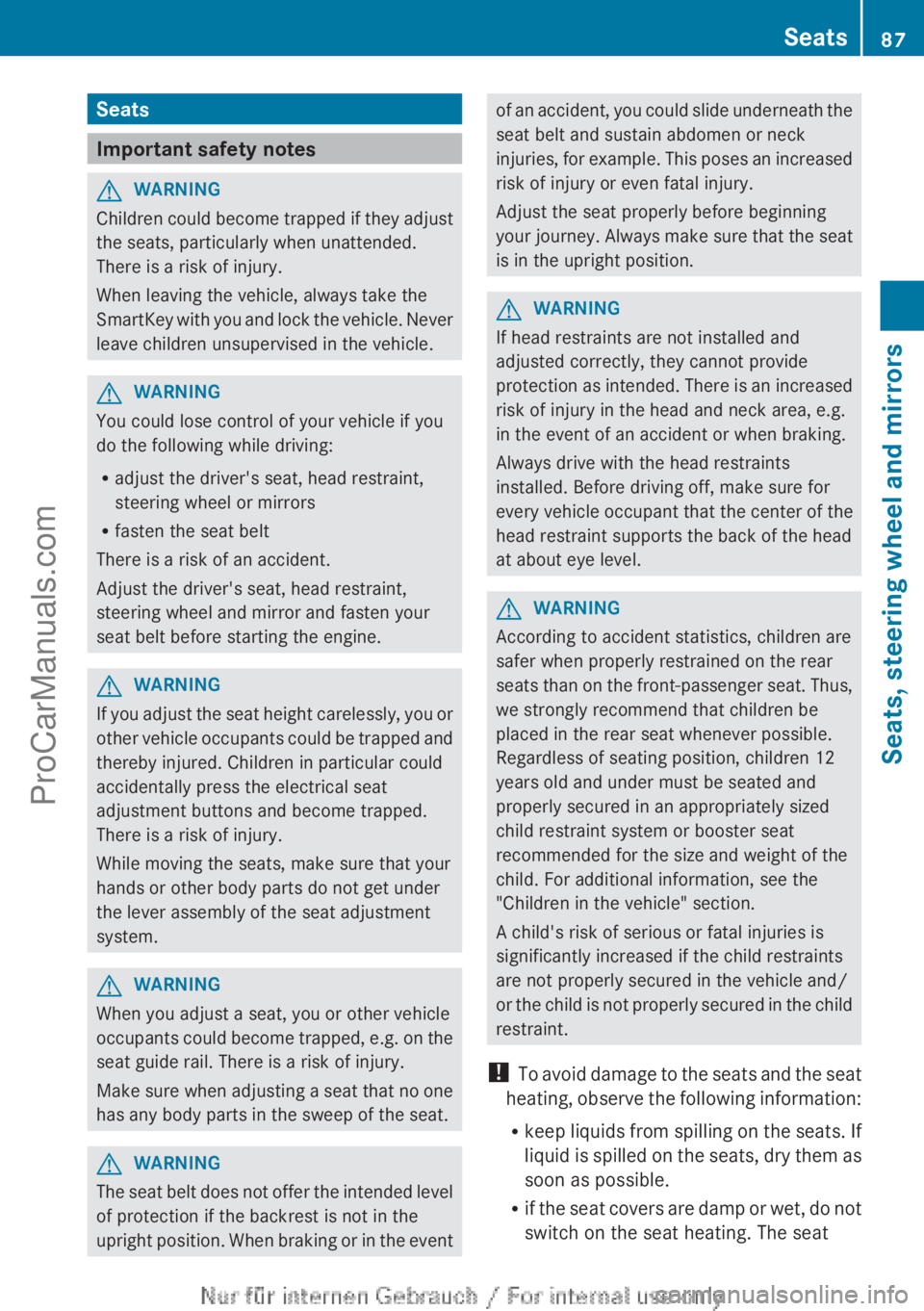2012 MERCEDES-BENZ B-CLASS seat adjustment
[x] Cancel search: seat adjustmentPage 8 of 340

Power washer ................................
272
Rear view camera .......................... 275
Roof lining ...................................... 277
Seat belt
........................................ 277
Seat cover ..................................... 276
Sensors ......................................... 275
Steering wheel ............................... 276
Trim pieces .................................... 276
Washing by hand ........................... 272
Wheels ........................................... 273
Windows ........................................ 274
Wiper blades .................................. 274
Wooden trim .................................. 276
Cargo compartment cover ...............244
Cargo compartment enlargement ...240
Important safety notes .................. 240
Notes on use ................................. 242
Cargo compartment floor
Height adjustment .........................246
Important safety notes .................. 245
Opening/closing ............................ 246
Stowage well (under) ..................... 245
Cargo net
Attaching ....................................... 245
Important safety information ......... 245
Cargo tie down rings .........................243
Car wash (care) ................................. 271
Center console Lower section .................................. 33
Upper section .................................. 32
Central locking
Automatic locking (on-board
computer) ...................................... 198
Locking/unlocking (SmartKey) ........ 68
Changing bulbs
Brake lamps ................................... 109
Cornering light function .................108
High-beam headlamps ...................107
Important safety notes .................. 104
License plate lighting .....................111
Low-beam headlamps .................... 107
Overview of bulb types ..................105
Parking lamps ................................ 108
Rear fog lamp ................................ 109
Removing/replacing the cover
(front wheel arch) .......................... 106
Reversing lamps ............................ 109
Standing lamps (front) ...................108Tail lamps
...................................... 109
Turn signals (front) ......................... 108
Turn signals (rear)
..........................109
Child-proof locks
Important safety notes .................... 57
Rear doors ....................................... 58
Children
In the vehicle ................................... 50
Restraint systems ............................ 50
Child seat
Automatic recognition ..................... 53
LATCH-type (ISOFIX) child seat
anchors ............................................ 54
On the front-passenger seat ............52
Problem (malfunction) .....................57
Top Tether ....................................... 55
Cigarette lighter ................................ 250
Climate control Automatic climate control ............. 119
Automatic climate control (dual-
zone) .............................................. 121
Controlling automatically ...............125
Cooling with air dehumidification ..123
Defrosting the windows ................. 127
Defrosting the windshield .............. 127
Important safety notes .................. 118
Indicator lamp ................................ 125
Maximum cooling .......................... 127
Notes on using automatic climate
control ................................... 120, 122
Overview of systems ...................... 118
Problems with cooling with air
dehumidification ............................ 125
Problem with the rear window
defroster ........................................ 129
Refrigerant ..................................... 334
Refrigerant filling capacity .............335
Setting the air distribution .............126
Setting the airflow ......................... 126
Setting the air vents ......................130
Setting the temperature ................ 125
Switching air-recirculation mode
on/off ............................................ 129
Switching on/off ........................... 123
Switching residual heat on/off ...... 1296
Index
ProCarManuals.com
Page 16 of 340

Q
Qualified specialist workshop ...........24R
Radar sensor system Activating/deactivating .................199
Display message
............................ 215
Radio
Selecting a station .........................192
see separate operating instructions
Reading lamp ..................................... 103
Rear compartment Setting the air vents ......................131
Rear fog lamp
Changing bulbs .............................. 109
Display message ............................ 210
Switching on/off ........................... 100
Rear lamps
Changing bulbs .............................. 109
see Lights
Rear seat
Adjusting the angle of the
backrests ....................................... 242
Folding the backrest forwards/
back (vehicles without the EASY-
VARIO-PLUS system) .....................240
Folding the backrest forwards/
back (vehicles with the EASY-
VARIO-PLUS system) .....................241
Fore-and-aft adjustment ................243
Rear view camera
Cleaning instructions ..................... 275
Function/notes ............................. 176
Switching on/off ........................... 177
Rear-view mirror
Anti-glare (manual) ..........................92
Dipping (automatic) .........................93
Rear window defroster
Problem (malfunction) ...................129
Switching on/off ........................... 128
Rear window wiper
Replacing the wiper blade .............. 113
Switching on/off ........................... 112
Refrigerant (air-conditioning
system)
Important safety notes .................. 334Refueling
Fuel gauge ....................................... 29
Important safety notes
..................147
Refueling process .......................... 148
see Fuel
Remote control
Garage door opener .......................260
Programming (garage door opener) 260
Reporting safety defects .................... 25
Reserve (fuel tank) see Fuel
Reserve fuel
Display message ............................ 214
Warning lamp ................................. 231
see Fuel
Residual heat (climate control) ........129
Restraint system see SRS (Supplemental Restraint
System)
Reversing feature
Panorama sliding sunroof ................ 80
Roller sunblinds ............................... 81
Side windows ................................... 77
Roadside Assistance (breakdown) ....22
Roller sunblind Opening/closing .............................. 82
Panorama roof with power tilt/
sliding panel ..................................... 81
Roof carrier ........................................ 247
Roof lining and carpets (cleaning
guidelines) ......................................... 277
Roof load (maximum) ........................335
Route (navigation) see Route guidance (navigation)
Route guidance (navigation) ............191 S
Safety Children in the vehicle .....................50
Child restraint systems ....................50
Safety system
see Driving safety systems
Seat
Folding the backrest (rear
compartment) forwards/back14
Index
ProCarManuals.com
Page 49 of 340

touch the neck. Never pass the shoulder
portion of
the
seat belt under your arm. For
this purpose, you can adjust the height of
the seat belt outlet.
R Position the lap belt as low as possible on
your hips and not across the abdomen. If
the lap belt is positioned across your
abdomen, it could cause serious injuries in
a crash.
R Never wear seat belts over rigid or
breakable objects in or on your clothing,
such as eyeglasses, pens, keys etc., as
these might cause injuries.
R Make sure the seat belt is always fitted
snugly. Take special care of this when
wearing loose clothing.
R Never use a seat belt for more than one
person at a time. Do not fasten a seat belt
around a person and another person or
other objects at the same time.
R Seat belts should not be worn twisted. In a
crash, you would not have the full width of
the seat belt to distribute impact forces.
The twisted seat belt against your body
could cause injuries.
R Pregnant women should also always use a
lap-shoulder belt. The lap belt portion
should be positioned as low as possible on
the hips to avoid any possible pressure on
the abdomen.
R Place the seat backrest in a position that is
as upright as possible.
R Check your seat belt during travel to make
sure it is properly positioned.
R Never place your feet on the instrument
panel, dashboard, or on the seat. Always
keep both feet on the floor in front of the
seat.
R When using a seat belt to secure infant
restraints, toddler restraints, or children in
booster seats, always follow the child seat
manufacturer's instructions. G
WARNING
Do not pass seat belts over sharp edges. They
could tear.
Do not allow
the seat belt to get caught in the
door or in the seat adjustment mechanism.
This could damage the seat belt.
Never attempt to make modifications to seat
belts. This could impair the effectiveness of
the seat belts.
Fastening seat belts G
WARNING
According to accident statistics, children are
safer when properly restrained on the rear
seats than on
the front-passenger seat. Thus,
we strongly recommend that children be
placed in the rear seat whenever possible.
Regardless of seating position, children 12
years old and under must be seated and
properly secured in an appropriately sized
child restraint system or booster seat
recommended for the size and weight of the
child. For additional information, see the
"Children in the vehicle" section.
A child's risk of serious or fatal injuries is
significantly increased if the child restraints
are not properly secured in the vehicle and/
or the child is not properly secured in the child
restraint. Occupant safety
47
Safety Z
ProCarManuals.com
Page 50 of 340

X
Adjust the seat and move the backrest to
an almost vertical position ( Y page 86).
X Pull the seat belt smoothly through belt
sash guide :.
X Without twisting it, guide the shoulder
section of the seat belt across the middle
of your shoulder
and the lap section across
your pelvis.
X Engage belt tongue ; in buckle =.
X If necessary, adjust the seat belt to the
appropriate height ( Y page 48).
X If necessary, pull upwards on the shoulder
section of the seat belt to tighten the belt
across your body.
Information on releasing the seat belt with
release button
?(Y page 48).
Belt height adjustment You can adjust the seat belt height on the
front seats. Adjust the belt to a height that
allows the upper part of the seat belt to be
routed across the center of your shoulder.
X
To raise: slide the belt sash guide upwards.
The belt sash guide engages in various
positions.
X To lower: press and hold belt sash guide
release :
.
X Slide the belt sash guide downwards.
X Release belt sash guide release : and
make sure that the belt sash guide has
engaged. Using the seat belt for the center rear-
compartment seat If the left-hand rear seat backrest is folded
down and
back
up again, the rear center seat
belt may lock. The seat belt can then not be
pulled out.
X To release the rear center seat belt: pull
the seat belt out approximately 1 in
(25 mm) at the belt outlet on the backrest
and then release it again.
The seat belt is retracted and released.
Releasing seat belts !
Make sure
that
the seat belt is fully rolled
up. Otherwise, the seat belt or belt tongue
will be trapped in the door or in the seat
mechanism. This could damage the door,
the door trim panel and the seat belt.
Damaged seat belts can no longer fulfill
their protective function and must be
replaced. Visit a qualified specialist
workshop. X
Press release button ?
on belt
buckle =.
X Guide belt tongue ; back to belt sash
guide :.48
Occupant safety
Safety
ProCarManuals.com
Page 53 of 340

passenger front air bag is deactivated.
Should the 4 5 indicator lamp not
illuminate or go out while the restraint is
installed, please check installation.
Periodically check
the 4
5 indicator
lamp while driving to make sure the 4
5 indicator lamp is illuminated. If the
4 5 indicator lamp goes out or
remains out, do not transport a child on the
front passenger seat until the system has
been repaired.
A child in a rear-facing child restraint on the
front passenger seat will be seriously
injured or even killed if the front passenger
front air bag inflates.
R If you have to place a child in a forward-
facing child restraint on the front passenger
seat, move the seat as far back as possible,
use the proper child restraint
recommended for the age, size and weight
of the child, and secure child restraint with
the vehicle's seat belt according to the
child seat manufacturer's instructions. G
WARNING
Infants and small children should never share
a seat belt
with another occupant. In the event
of an accident, they could be crushed
between the occupant and seat belt.
A child's risk of serious or fatal injuries is
significantly increased if the child restraints
are not properly secured in the vehicle and/
or the child is not properly secured in the child
restraint.
Children that are too large for a child restraint
must travel in seats using normal seat belts.
Position the shoulder belt across the chest
and shoulder, not the face or neck. A booster
seat may be necessary to achieve proper seat
belt positioning for children over 41 lbs
(18 kg) until they reach a height where a lap/
shoulder belt fits properly without a booster
seat.
When the child restraint is not in use, remove
it from the vehicle or secure it with the seat
belt to prevent the child restraint from becoming a projectile in the event of an
accident.
G
WARNING
When leaving the vehicle, always remove the
SmartKey from the ignition lock. Always take
the SmartKey with you and lock the vehicle.
Do not leave children unattended in the
vehicle, even if they are secured in a child
restraint system, or with access to an
unlocked vehicle. A child's unsupervised
access to a
vehicle could result in an accident
and/or serious personal injury. The children
could:
R injure themselves on parts of the vehicle
R be seriously or fatally injured through
excessive exposure to extreme heat or cold
R injure themselves or cause an accident with
vehicle equipment that can be operated
even if the SmartKey is removed from the
ignition lock or removed from the vehicle,
such as seat adjustment, steering wheel
adjustment, or the memory function
If children open a door, they could injure other
persons or get out of the vehicle and injure
themselves or be injured by following traffic.
Do not expose the child restraint system to
direct sunlight. The child restraint system's
metal parts, for example, could become very
hot, and the child could be burned on these
parts. G
WARNING
Do not carry heavy or hard objects in the
passenger compartment or
trunk unless they
are firmly secured in place.
Unsecured or improperly positioned cargo
increases a child's risk of injury in the event
of
R strong braking maneuvers
R sudden changes of direction
R an accident Children in the vehicle
51
Safety Z
ProCarManuals.com
Page 60 of 340

such as seat adjustment, steering wheel
adjustment, or the memory function
If children open
a door, they could injure other
persons or get out of the vehicle and injure
themselves or be injured by following traffic.
Do not expose the child restraint system to
direct sunlight. The child restraint system's
metal parts, for example, could become very
hot, and the child could be burned on these
parts.
Child-proof locks for the rear doors G
WARNING
Children could open a rear door from inside
the vehicle. This could result in serious
injuries or an accident. Therefore, when
children ride in
the rear always secure the rear
doors with the child-proof locks. You can secure each door individually with
the child-proof
locks
on the rear doors. A door
secured with a child-proof lock cannot be
opened from inside the vehicle. When the
vehicle is unlocked, the door can be opened
from the outside.
X To activate: press the child-proof lock
lever up in the direction of arrow :.
X Make sure that the child-proof locks are
working properly.
X To deactivate: press the child-proof lock
lever down in the direction of arrow ;. Override feature for the rear side
windows G
WARNING
When children ride on the vehicle's rear seats,
activate the override switch. Otherwise, the
children could be injured, e.g. by trapping
themselves in the rear side window. X
To activate/deactivate: press button :.
If
indicator lamp is lit, operation of the rear
side windows is disabled. Operation is only
possible using the switches in the driver's
door. If the indicator lamp is off, operation
is possible using the switches in the rear
compartment. Driving safety systems
Overview of driving safety systems
In this section,
you will find information about
the following driving safety systems:
R ABS ( Anti-lock Braking System)
(Y page 64)
R BAS ( Brake Assist System) ( Y page 59)
R COLLISION PREVENTION ASSIST (adaptive
Brake Assist and distance warning signal)
(Y page 60)
R Adaptive brake lights ( Y page 62)
R ESP ®
(Electronic Stability Program)
(Y page 62)
R EBD ( Electronic Brake force Distribution)
(Y page 64) 58
Driving safety systems
Safety
ProCarManuals.com
Page 88 of 340

Useful information
i This Operator's Manual describes all
models and all standard and optional
equipment of your vehicle available at the
time of publication of the Operator's
Manual. Country-specific differences are
possible. Please note
that your vehicle may
not be equipped with all features
described. This also applies to safety-
related systems and functions.
i Read the information on qualified
specialist workshops: ( Y page 24).Correct driver's seat position
Observe the safety guidelines on seat
adjustment (
Y page 87).
X Make sure that seat = is adjusted
properly.
Manual seat adjustment ( Y page 88)
Electrical seat adjustment ( Y page 88)
When adjusting the seat, make sure that:
R you are as far away from the driver's air
bag as possible.
R you are sitting in a normal upright
position.
R you can fasten the seat belt properly. R
you have moved the backrest to an
almost vertical position.
R you have set the seat cushion angle so
that your thighs are gently supported.
R you can depress the pedals properly.
X Check whether the head restraint is
adjusted properly ( Y page 89).
When doing so, make sure that you have
adjusted
the head restraint so that the back
of your head is supported at eye level by
the center of the head restraint.
Observe the safety guidelines on steering
wheel adjustment ( Y page 91).
X Make sure that steering wheel : is
adjusted properly.
Adjusting the steering wheel
(Y page 91)
When adjusting the steering wheel, make
sure that:
R you can hold
the steering wheel with your
arms slightly bent.
R you can move your legs freely.
R you can see all the displays in the
instrument cluster clearly.
Observe the safety guidelines for seat belts
(Y page 45).
X Check whether you have fastened seat
belt ; properly ( Y page 47).
The seat belt should:
R fit snugly across your body
R be routed across the middle of your
shoulder
R be routed in your pelvic area across the
hip joints
X Before starting off, adjust the rear-view
mirror and the exterior mirrors
(
Y page 92) in such a way that you have
a good view of road and traffic conditions.
X Vehicles with a memory function: save
the seat and exterior mirror settings
(Y page 95). 86
Correct driver's seat position
Seats, steering wheel and mirrors
ProCarManuals.com
Page 89 of 340

Seats
Important safety notes
G
WARNING
Children could become trapped if they adjust
the seats, particularly when unattended.
There is a risk of injury.
When leaving the vehicle, always take the
SmartKey with you
and lock the vehicle. Never
leave children unsupervised in the vehicle. G
WARNING
You could lose control of your vehicle if you
do the following while driving:
R adjust the driver's seat, head restraint,
steering wheel or mirrors
R fasten the seat belt
There is a risk of an accident.
Adjust the driver's seat, head restraint,
steering wheel and mirror and fasten your
seat belt before starting the engine. G
WARNING
If you adjust the seat height carelessly, you or
other vehicle occupants
could be trapped and
thereby injured. Children in particular could
accidentally press the electrical seat
adjustment buttons and become trapped.
There is a risk of injury.
While moving the seats, make sure that your
hands or other body parts do not get under
the lever assembly of the seat adjustment
system. G
WARNING
When you adjust a seat, you or other vehicle
occupants could become
trapped, e.g. on the
seat guide rail. There is a risk of injury.
Make sure when adjusting a seat that no one
has any body parts in the sweep of the seat. G
WARNING
The seat belt does not offer the intended level
of protection if the backrest is not in the
upright position. When
braking or in the event of an accident, you could slide underneath the
seat belt and sustain abdomen or neck
injuries, for
example.
This poses an increased
risk of injury or even fatal injury.
Adjust the seat properly before beginning
your journey. Always make sure that the seat
is in the upright position. G
WARNING
If head restraints are not installed and
adjusted correctly, they cannot provide
protection as intended.
There is an increased
risk of injury in the head and neck area, e.g.
in the event of an accident or when braking.
Always drive with the head restraints
installed. Before driving off, make sure for
every vehicle occupant that the center of the
head restraint supports the back of the head
at about eye level. G
WARNING
According to accident statistics, children are
safer when properly restrained on the rear
seats than on
the front-passenger seat. Thus,
we strongly recommend that children be
placed in the rear seat whenever possible.
Regardless of seating position, children 12
years old and under must be seated and
properly secured in an appropriately sized
child restraint system or booster seat
recommended for the size and weight of the
child. For additional information, see the
"Children in the vehicle" section.
A child's risk of serious or fatal injuries is
significantly increased if the child restraints
are not properly secured in the vehicle and/
or the child is not properly secured in the child
restraint.
! To avoid damage to the seats and the seat
heating, observe the following information:
R keep liquids from spilling on the seats. If
liquid is spilled on the seats, dry them as
soon as possible.
R if the seat covers are damp or wet, do not
switch on the seat heating. The seat Seats
87
Seats, steering wheel and mirrors Z
ProCarManuals.com